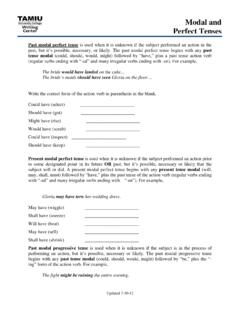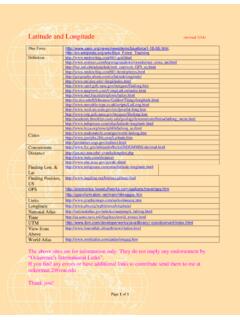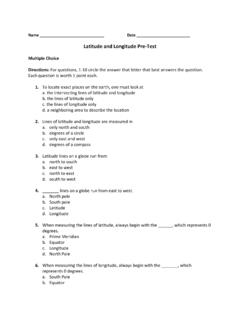Transcription of page - 1 Laboratory Exercise #1 - Introduction to …
1 Page - 1 Laboratory Exercise #1 - Introduction to Latitude and LongitudeA. IntroductionThere are many methods that can be used to locate ones position on the surface of the earth. A common method for location includes use of landmarks and features on the earth s surface, which may not always provide the sufficient detail needed to confidently locate one s position. The method that is universally accepted involves using latitude and longitude , which can provide a highly precise means for locating any place on the planet. Most formalized methods for location, such as latitude and longitude , involve using a grid system that is superimposed on the earth s Overview of Latitude Latitude defines location on the planet in terms of north or south (Figure 1a). Lines of latitude are also called parallels and define a full circle on the surface of the earth.
2 Zero degrees latitude is defined as the equator, the boundary between the northern and southern hemispheres (Figure 1a). All points north of the equator are within the northern hemisphere and will always have North latitudes. All points south of the equator are within the southern hemisphere and will always have South 1. a) Schematic of the earth with the northern and southern hemispheres labeled. b) The earth with lines of latitude labeled at every 30 maximum number of degrees of latitude that can be present on the earth s surface is 90o. The North Pole has a latitude of 90o N; the South Pole is 90o S. Additionally, parallels of latitude are commonly labeled on world maps or globes normally in 15 or 30o intervals (Figure 1b). EquatorNorthernHemisphereSouthernHemisph ereEquatorNorthernHemisphereSouthernHemi sphere0o30o S30o N60o N90o N60o S90o - 2 Important terminology that will be used in lecture and later labs: Learn It !
3 Low Latitudes are defined as: either N or S 0 to 30o Middle Latitudes are defined as: either N or S 30 to 60o High Latitudes are defined as: either N or S 60 to 90oRealize that degrees of latitude actually equates to distance (Figure 2). Traveling one degree of latitude is equivalent to traveling approximately 60 2. Diagram showing the relationship between degrees of latitude and ground example, suppose you are located at a latitude of 30o N. Note that many places on the planet are also located at approximately 30o N such as Austin, TX, northern Florida, or northern Africa (Figure 3).Figure 3. World map showing different geographic places along the same N90o S1o NEquator0o60 miles 30o NorthLatitudeLaredopage - 3 Questions:1.
4 What is the minimum number of degrees of latitude that can exist on the earth ? _____ o2. Give the latitude of the features on the earth that are the furthest away from the equator. _____ and _____3. What is your favorite town and what is its approximate latitude? Note: that latitude is always written in the following format:##o N if you are in the northern hemisphere or##o S if you are in the southern hemisphere . _____, _____ o ____ 4. Is your favorite town located at a low, middle, or high latitude? How many miles is your favorite town located away from the equator?6. In which hemisphere (north or south) is: North America _____ ? Australia _____ ?7. Can you locate yourself by just using latitude?
5 Explain in detail. (Hint: read page 2 very carefully)C. Overview of longitude longitude , the second part of this locating system, defines a position on the planet in terms of east or west. Unlike parallels of latitude, which are defined by full circles, lines of longitude (or meridians, as they are also called) form half circles which go from the north to the south pole and do not encircle the whole planet (Figure 4). page - 4 Figure 4. Globe showing meridians going from the north to the south the equator, which is defined as a circle exactly halfway between the north and south pole, the zero degree meridian of longitude (the prime meridian) was arbitrarily defined. The prime meridian is a line draw from the north to the south pole and is drawn through the city of Greenwich, England; because the British were the first to formalize longitude as a measure of east-west position (Figure 5).
6 Figure 5. Globes with the prime meridian, western and eastern hemispheres N - North Pole90o S - South PolePrime MeridianEnglandEasternHemisphereWesternH emisphere90o N - North Pole90o S - South PoleN0o30o E30o W60o E60o W90o E90o W120o E120o W150o W150o E180oEastern HemisphereWestern HemispherePrimeMeridianInternationalDate Linepage - 5 Question: Are lines of longitude parallel to each other? Answer: , lines of longitude are called meridians, which literally mean pie-shaped wedges (Figure 6). Figure 6. Diagram showing the pie-shaped nature of meridians (lines of longitude ).Because meridians are not parallel to each other, the distance between adjacent meridians is different at the equator versus at the poles. For example: Meridians are located furthest away from each other at the equator.
7 Meridians intersect with each other precisely at the poles. The distances between meridians becomes less with higher :8. What is the maximum number of degrees of longitude that are possible? _____ o9. What is your favorite town and what is its approximate longitude ? Note: that longitude is always written in the following format:###o W if you are in the western hemisphere or###o E if you are in the eastern hemisphere . _____, _____ o ____10. In which hemisphere (west or east) is: North America _____ ? Australia _____ ?90o N - North Pole90o S - South Polepage - 6D. Using Latitude and longitude From the preceding discussion you should realize at this point that in the continental United States latitudes are always north and longitudes are always west (Figure 7).
8 These facts result from the fact that the United States is north of the equator (in the northern hemisphere ) and west of the prime meridian (in the western hemisphere ).ARCTICOCEANPACIFICOCEANATLAN TICOCEAN 30 N30 N15 N60 W75 W90 W105 W120 W15 N45 N45 N60 N60 N75 N75 N page - 7 Figure 7. Map showing the continental United States in terms of latitude and , you should learn how to write the coordinates of latitude and longitude of a location on the earth in the correct format. Note that failure to correctly write latitude and longitude in the right format will result in a loss of points on your Laboratory assignment. Latitude is always written first and longitude second as indicated below: ##o N, ###o WYou not only need to write latitude and longitude correctly but also need to be able to determine the latitude and longitude of a point on a map.
9 Refer to the map on Figure locations of points 1 to 4 on Figure 8 are as follows:Point 1 occurs on both a parallel and meridian and its location can be directly determined by examining the map. 15o N, 30o WPoint 2 occurs on the equator and a meridian. The latitude on the map (equator) is defined as 0o and the longitude can be determined from the meridian on the map. 0o, 90o EPoint 3 occurs on a parallel and the prime meridian. The latitude can be determined from the parallel on the map and the longitude is defined as 0o. 75o N, 0oPoint 4 does not occur on either a parallel or meridian and must be determined by interpolating the latitude and longitude between the parallels or meridians. Note that on a global scale the error associated with interpolating latitude and longitude can be as great as a few degrees 5o S, 102o Wpage - 8 D 0 15 N30 N45 N60 N75 N90 N15 S30 S45 S15 W30 W45 W60 W90 W75 W105 W120 W135 W150 W165 W180 W90 E15 E30 E45 E60 E75 E105 E120 E135 E150 E165 E180 E60 S75 S90 SA4D1E3F2 BCpage - 9 Figure 8.
10 World map with points labeled for homework :Answer the following questions by looking at the world map (Figure 8).11. Find points A to F on Map #1. Determine the correct latitude (N or S) and longitude (E or W) of these points in _____ D. _____ B. _____ E. _____C. _____ F. _____12. Place a dot and the letter (I to L) on the world map (Figure 8) based on the coordinates listed below (please make the dots and letters are large enough to read).I. 0o , 100o E K. 45o S, 130o WJ. 35o N, 110o E L. 30o N, 70o WE. Making a Three-Dimensional Globe a Two-Dimensional MapMost maps are two-dimensional representations of our three-dimensional planet. To produce a map requires us to conceptually peel the planet and flatten the world out to get a paper map.



















